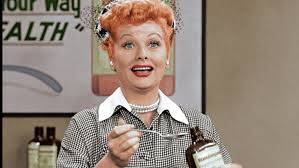(This is the sixth chapter of a book-in-progress, “Television, and How It Got That Way.” For the previous chapters, scroll down under “stories.”)
As the 1951 season began, TV had a split personality.
Yes, there were promising signs from Sid Caesar, Ed Sullivan and lots of live dramas But there were also remnants of TV’s primitive start.
Look around prime time that fall and you’d find wrestling (twice) and boxing (twice). You’d find the “Georgetown University Forum” and “Johns Hopkins Science Review”; “Youth on the March” and “American Youth Forum.” You’d find “Marshall Plan in Action,” “Film Filler” and “Lessons in Safety.”
And into that shaky field – on Oct. 15, 1951 – “I Love Lucy” (shown here) debuted. It instantly fulfilled “every promise of the often harassed new medium,” a Hollywood Reporter critic wrote, adding: “It should bounce to the top of the rating heap in no time.“
It did. On a typical Monday that first season, more than half of all TV homes watched “Lucy”; the second year, more than two-thirds did. The night Lucy had her baby, that hit 71.7 percent.
This was a variation of a character Lucille Ball had done on radio – the wide-eyed innocent, forever floating dreams and schemes. It fit her immense range, Jess Oppenheimer (who produced her radio comedy and “I Love Lucy”) wrote in “Laughs, Luck … and Lucy” (Syracuse University Press. 1996):
“Unexpected qualities appeared out of nowhere. Little, human, ordinary, recognizable values. Inflections that were exactly what your sister or your mother or the lady busdriver used. She was the everywoman.”
She had done that on radio; now she was moving to TV, with the same writers (Madelyn Pugh and Bob Carroll, Jr.) and the bonus of sight gags.
There was one catch: Radio was done with a studio audience; at this point, TV situation comedies weren’t.
“Lucy was dreadful without an audience,” CBS executive Harry Ackerman once said. “She absolutely bloomed in front of an audience.”
She insisted that “I Love Lucy” have one. A legend persisted that Desi Arnaz (her co-star, producer and husband) had invented the method of shooting a sitcom before an audience.
“No particular person came up with the idea,” Oppenheimer said in 1973. “It developed in conferences and was dictated by necessity.” In his memoir, he offered details.
Lots of shows were shown live on connected stations on the East Coast. The rest of the country would get a so-so kinescope copy.
But Ball wanted to do the opposite – perform on the West Coast, then send kinescopes east. Back then, that meant 85 percent of viewers would get a bad copy.
The sponsor objected; Ball insisted on LA. Arnaz and others found a compromise — using four cameras, each loaded with film so no one would have to settle for kinescope.
The multi-camera idea “had been around since the late 1920s” in Hollywood, Oppenheimer wrote. It reached TV in the late ‘40s, Coyne Steven Sanders and Tom Gilbert wrote in “Desilu” (Morrow, 1993). It was used on “Public Prosecutor,” “Silver Theater,” “Truth or Consequences” and “Amos and Andy.”
But that last one was the only sitcom and it had a makeshift approach: It shot each episode with three cameras, but no audience. Then an audience was brought in to laugh at the result.
That missed the key part, Oppenheimer said — reacting to the audience. “There is that quality, that response, that comes only from a live experience. And the American audience had learned to expect this, after 25 years of listening to studio audiences laughing on radio.”
Now “I Love Lucy” wanted to do it all – four cameras, each rolling with film, yet not getting in the way of the studio audience. There were adjustments – an overall lighting system … long-lens cameras … and financial moves.
This new system was adding to the budget, CBS said; the stars would have to take a pay cut. Arnaz agreed – but only if he and Ball owned the shows after they aired.
For most shows, that would have been useless. Even Caesar’s comedies or the golden-age dramas had little value as shaky kinescopes.
But these “Lucy” episodes were different – crisp, black-and-white film, shot in Hollywood. “Desi had, in effect, invented the rerun market,” Sanders and Gilbert wrote.
The episodes eventually reran on CBS daytime … and on individual stations … and even in a few colorized primetime specials. They were worth millions and were the basis for what followed.
Buoyed by profits from reruns, the Desilu company bought RKO Studios, eventually expanding to 33 sound stages. It produced “The Untouchables” and (after Arnaz left in 1962) “Star Trek,” “Mission: Impossible,” “Mannix” and more.
After running the company for five years, Ball sold it to Paramount’s parent company in ‘67. The old Desilu shows fueled Paramount’s movie business, with “Star Trek,” “Untouchables” and Tom Cruise’s “Mission: Impossible” empire. Then “Star Trek” became the key piece of the Paramount+ streamer.
There was also an irony: Six weeks before “I Love Lucy” debuted, CBS completed a link that connected its stations. If they knew that was coming, the “Lucy” people might have skipped the idea of using film and owning reruns
But they didn’t, Oppenheimer wrote. They created “the technical innovations that would contribute so much to the success of ‘I Love Lucy,’ the growth of the Desilu empire, and the eventual shift of the center of television production from New York to Hollywood.”
In the years that followed, many sitcoms would use the “Lucy” techniques and some would shoot on the old Desilu stages. By accident or not, some had rhythms and characters that were similar to the “Lucy” ones.
Some of those shows would be awful, but others fueled two comedy golden ages. TV was going far away from “Film Filler” and “Lessons in Safety.”
